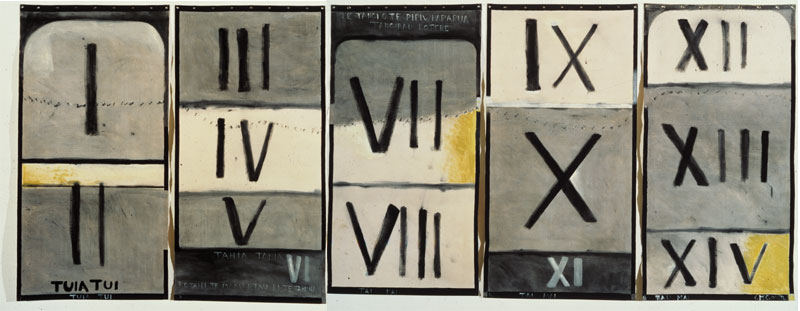
Te tangi o te pipiwhararua. (The song of the shining cuckoo) from a poem by Tangirau Hotere, by Colin McCahon, 1974.
In 1974, one of New Zealand’s greatest painters, Colin McCahon, painted a work called “The Song of the Shining Cuckoo,” based on a waiata that had been sent to him by his friend Ralph Hotere, who in turn had received it from his father Tangihau Hotere, of Te Rarawa iwi from north Hokianga.
In the tradition of Hokianga Maori, pipiwharauroa embody the essence of those who have recently died and whose spirits make their way northward along the western coastline to Cape Reinga, the place of departure for the spirit’s return to Hawaiki.
The words of the waiata are these:
Te Tangi o te Pipiwhararua
Tuia tuiTahi tahia
Kotahi te manu i tau ki te tahuna
Tau mai
Tau mai
Tau mai
The Song of the Shining Cuckoo
Bind us together
Clear a space
A bird alights on the sandbank
Alight
Alight
Rest
The chant is both a welcome to travellers visiting the marae and an acknowledgement of the spirit’s flight.
McCahon painted the work in the month of October, in his studio at Muriwai Beach, north of Auckland. So he was working on the painting at the very time that the shining cuckoos were arriving from over the sea—the Tasman Sea that was crashing on the sand beyond his studio.
The link between the shining cuckoo and the spiritual world is fascinating—especially considering the cuckoo’s unsavoury start to life. From a human point of view, this is a bird with “issues.” It cons an innocent grey warbler into raising its chick, which then shows its gratitude by killing the warbler’s own family. Not a great role model! And not a prime candidate, it would seem, for being an emblem of the spirit’s passage after death.*
But perhaps we can understand the cuckoo’s domestic issues in a different way. The grey warbler will usually have raised a clutch of eggs before the shining cuckoos arrive from overseas. Its survival does not seem threatened by the cuckoo’s parasitism. Perhaps we could see (metaphorically) the grey warbler’s selfless raising of a foster chick as an act of charity and hospitality—a decision to show manaakitanga.
And what about the Hokianga people’s choice of pipiwharauroa as a symbol of both earthly visitors and spiritual travellers? Melbourne philosopher Freya Mathews writes, “Perhaps they were chosen for this sacred role of travelling in two realms because they were never really at home in this world, having had to usurp the place of another. It makes sense that they should be the ones to show the way home—to the real home beyond the (for them) makeshift arrangements of this world. How satisfying!”
* This discussion about the symbolism of the cuckoo’s and grey warbler’s nesting habits is mere conjecture. It is not based on any Maori traditional understandings, but is simply an attempt to seek a metaphor for human living in the innate behaviour of two of our native birds.
Picture courtesy Otago University




